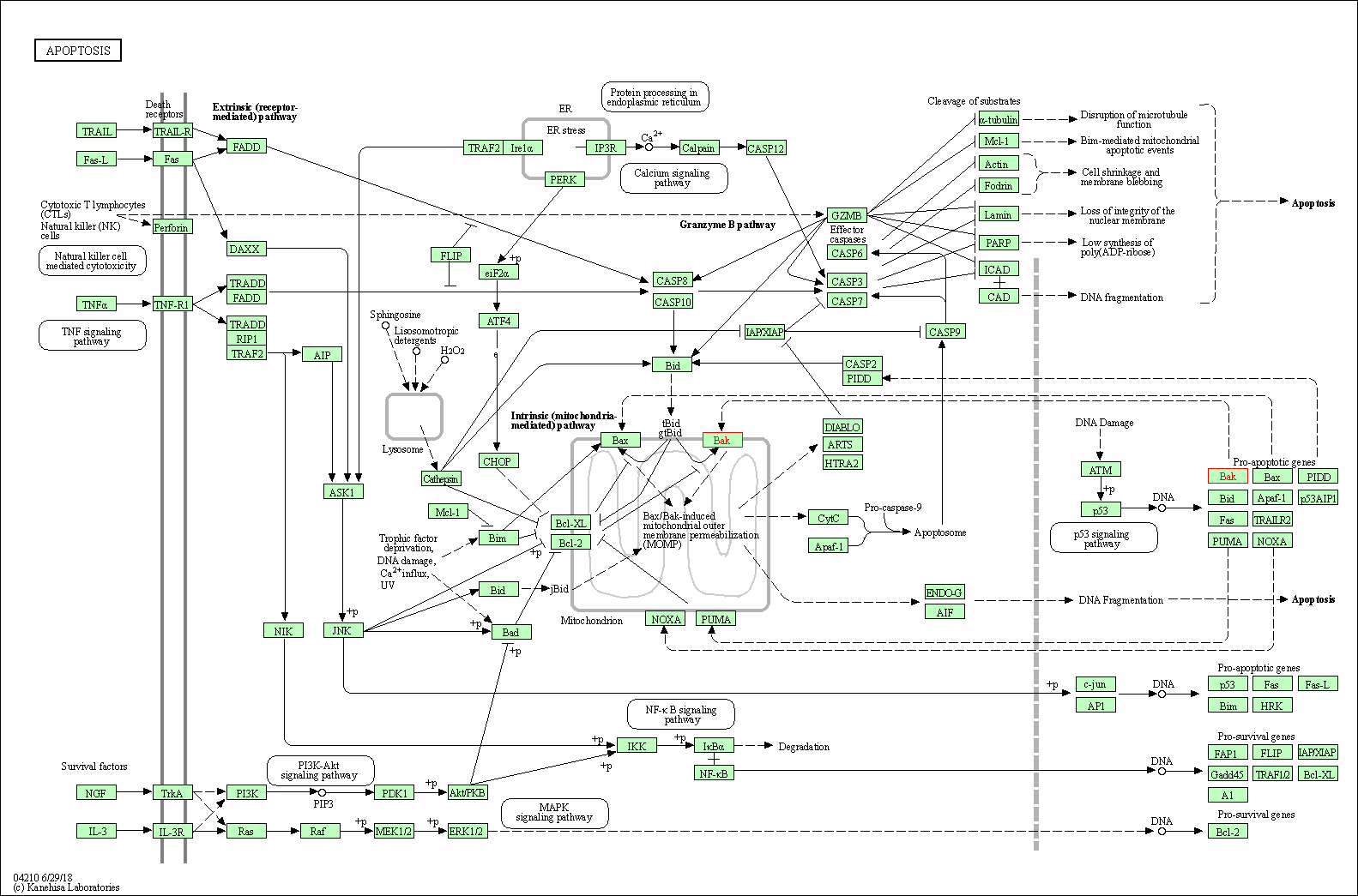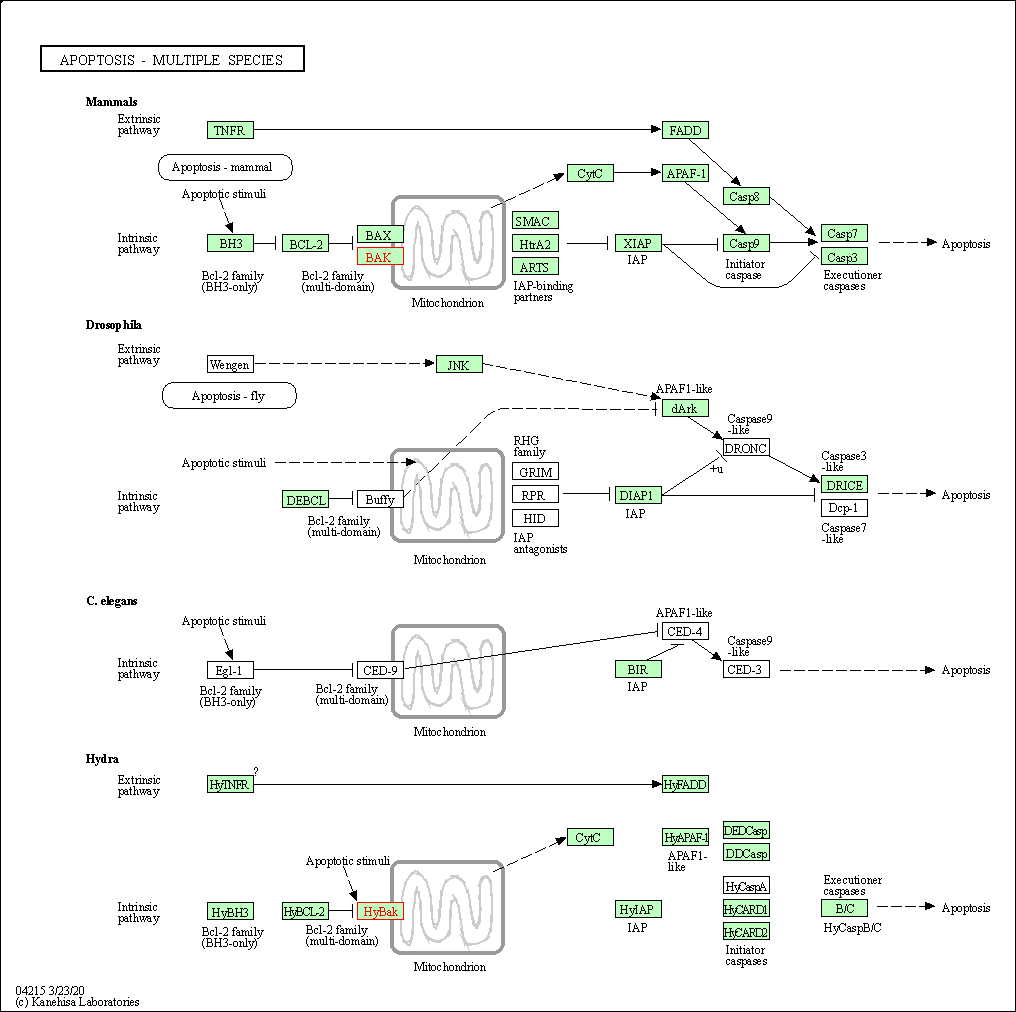Target Information
| Target General Information | Top | |||||
|---|---|---|---|---|---|---|
| Target ID |
T82254
(Former ID: TTDI02372)
|
|||||
| Target Name |
Apoptosis regulator BAK (BAK)
|
|||||
| Synonyms |
CDN1; Bcl2like protein 7; Bcl2L7; Bcl2-L-7; Bcl2 homologous antagonist/killer; Bcl-2-like protein 7; Bcl-2 homologous antagonist/killer
Click to Show/Hide
|
|||||
| Gene Name |
BAK1
|
|||||
| Target Type |
Literature-reported target
|
[1] | ||||
| Function |
Upon arrival of cell death signals, promotes mitochondrial outer membrane (MOM) permeabilization by oligomerizing to form pores within the MOM. This releases apoptogenic factors into the cytosol, including cytochrome c, promoting the activation of caspase 9 which in turn processes and activates the effector caspases. Plays a role in the mitochondrial apoptosic process.
Click to Show/Hide
|
|||||
| BioChemical Class |
B-cell lymphoma Bcl-2
|
|||||
| UniProt ID | ||||||
| Sequence |
MASGQGPGPPRQECGEPALPSASEEQVAQDTEEVFRSYVFYRHQQEQEAEGVAAPADPEM
VTLPLQPSSTMGQVGRQLAIIGDDINRRYDSEFQTMLQHLQPTAENAYEYFTKIATSLFE SGINWGRVVALLGFGYRLALHVYQHGLTGFLGQVTRFVVDFMLHHCIARWIAQRGGWVAA LNLGNGPILNVLVVLGVVLLGQFVVRRFFKS Click to Show/Hide
|
|||||
| 3D Structure | Click to Show 3D Structure of This Target | PDB | ||||
| HIT2.0 ID | T16Q09 | |||||
| Cell-based Target Expression Variations | Top | |||||
|---|---|---|---|---|---|---|
| Cell-based Target Expression Variations | ||||||
| Drug Binding Sites of Target | Top | |||||
|---|---|---|---|---|---|---|
| Ligand Name: (Hydroxyethyloxy)Tri(Ethyloxy)Octane | Ligand Info | |||||
| Structure Description | Crystal structure of BAK core domain BH3-groove-dimer in complex with POPC and C8E4 | PDB:6UXQ | ||||
| Method | X-ray diffraction | Resolution | 1.70 Å | Mutation | No | [2] |
| PDB Sequence |
GPLGSSTMGQ
73 VGRQLAIIGD83 DINRRYDSEF93 QTMLQHLQPT103 AENAYEYFTK113 IATSLFESGI 123 NWGRVVALLG133 FGYRLALHVY143 QHGL
|
|||||
|
|
||||||
| Ligand Name: (S)-2-Aminooctanedioic acid | Ligand Info | |||||
| Structure Description | Bak in complex with Bim-h3Pc | PDB:5VWZ | ||||
| Method | X-ray diffraction | Resolution | 1.62 Å | Mutation | Yes | [3] |
| PDB Sequence |
SMSEEQVAQD
30 TEEVFRSYVF40 YRHQQEQEAE50 GVAAPADPEM60 VTLPLQPSST70 MGQVGRQLAI 80 IGDDINRRYD90 SEFQTMLQHL100 QPTAENAYEY110 FTKIATSLFE120 SGINWGRVVA 130 LLGFGYRLAL140 HVYQHGLTGF150 LGQVTRFVVD160 FMLHHSIARW170 IAQRGGWVAA 180 LNLGNG
|
|||||
|
|
||||||
| Click to View More Binding Site Information of This Target with Different Ligands | ||||||
| Different Human System Profiles of Target | Top |
|---|---|
|
Human Similarity Proteins
of target is determined by comparing the sequence similarity of all human proteins with the target based on BLAST. The similarity proteins for a target are defined as the proteins with E-value < 0.005 and outside the protein families of the target.
A target that has fewer human similarity proteins outside its family is commonly regarded to possess a greater capacity to avoid undesired interactions and thus increase the possibility of finding successful drugs
(Brief Bioinform, 21: 649-662, 2020).
Human Tissue Distribution
of target is determined from a proteomics study that quantified more than 12,000 genes across 32 normal human tissues. Tissue Specificity (TS) score was used to define the enrichment of target across tissues.
The distribution of targets among different tissues or organs need to be taken into consideration when assessing the target druggability, as it is generally accepted that the wider the target distribution, the greater the concern over potential adverse effects
(Nat Rev Drug Discov, 20: 64-81, 2021).
Human Pathway Affiliation
of target is determined by the life-essential pathways provided on KEGG database. The target-affiliated pathways were defined based on the following two criteria (a) the pathways of the studied target should be life-essential for both healthy individuals and patients, and (b) the studied target should occupy an upstream position in the pathways and therefore had the ability to regulate biological function.
Targets involved in a fewer pathways have greater likelihood to be successfully developed, while those associated with more human pathways increase the chance of undesirable interferences with other human processes
(Pharmacol Rev, 58: 259-279, 2006).
Biological Network Descriptors
of target is determined based on a human protein-protein interactions (PPI) network consisting of 9,309 proteins and 52,713 PPIs, which were with a high confidence score of ≥ 0.95 collected from STRING database.
The network properties of targets based on protein-protein interactions (PPIs) have been widely adopted for the assessment of target’s druggability. Proteins with high node degree tend to have a high impact on network function through multiple interactions, while proteins with high betweenness centrality are regarded to be central for communication in interaction networks and regulate the flow of signaling information
(Front Pharmacol, 9, 1245, 2018;
Curr Opin Struct Biol. 44:134-142, 2017).
Human Similarity Proteins
Human Tissue Distribution
Human Pathway Affiliation
Biological Network Descriptors
|
|
|
There is no similarity protein (E value < 0.005) for this target
|
|
Note:
If a protein has TS (tissue specficity) scores at least in one tissue >= 2.5, this protein is called tissue-enriched (including tissue-enriched-but-not-specific and tissue-specific). In the plots, the vertical lines are at thresholds 2.5 and 4.
|
| KEGG Pathway | Pathway ID | Affiliated Target | Pathway Map |
|---|---|---|---|
| Protein processing in endoplasmic reticulum | hsa04141 | Affiliated Target |

|
| Class: Genetic Information Processing => Folding, sorting and degradation | Pathway Hierarchy | ||
| Apoptosis | hsa04210 | Affiliated Target |

|
| Class: Cellular Processes => Cell growth and death | Pathway Hierarchy | ||
| Apoptosis - multiple species | hsa04215 | Affiliated Target |

|
| Class: Cellular Processes => Cell growth and death | Pathway Hierarchy | ||
| Degree | 10 | Degree centrality | 1.07E-03 | Betweenness centrality | 1.14E-04 |
|---|---|---|---|---|---|
| Closeness centrality | 2.35E-01 | Radiality | 1.41E+01 | Clustering coefficient | 6.89E-01 |
| Neighborhood connectivity | 4.87E+01 | Topological coefficient | 1.36E-01 | Eccentricity | 11 |
| Download | Click to Download the Full PPI Network of This Target | ||||
| Target Regulators | Top | |||||
|---|---|---|---|---|---|---|
| Target-regulating microRNAs | ||||||
| Target-interacting Proteins | ||||||
| References | Top | |||||
|---|---|---|---|---|---|---|
| REF 1 | Novel BCL2 inhibitor, Disarib induces apoptosis by disruption of BCL2-BAK interaction. Biochem Pharmacol. 2017 May 1;131:16-28. | |||||
| REF 2 | BAK core dimers bind lipids and can be bridged by them. Nat Struct Mol Biol. 2020 Nov;27(11):1024-1031. | |||||
| REF 3 | Conversion of Bim-BH3 from Activator to Inhibitor of Bak through Structure-Based Design. Mol Cell. 2017 Nov 16;68(4):659-672.e9. | |||||
If You Find Any Error in Data or Bug in Web Service, Please Kindly Report It to Dr. Zhou and Dr. Zhang.

